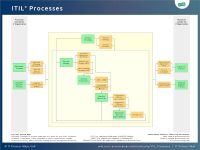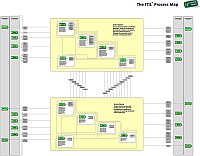ITIL Processes: Difference between revisions
mNo edit summary |
No edit summary |
||
| Line 1: | Line 1: | ||
<seo metakeywords="itil processes, itil process, itil v3 processes, itil v2 processes, itil disciplines" metadescription="ITIL | <seo metakeywords="itil processes, itil process, itil v3 processes, itil v2 processes, itil disciplines" metadescription="The ITIL processes within IT Service Management ensure that IT Services are provided in a focused, client-friendly manner. Take a look at the detailed ITIL process descriptions: ..." /> | ||
<imagemap> | <imagemap> | ||
Image:ITIL-Wiki-de-es.jpg|DE - ES - ITIL Processes - Processes ITIL V3|100px | Image:ITIL-Wiki-de-es.jpg|DE - ES - ITIL Processes - Processes ITIL V3|100px | ||
| Line 10: | Line 10: | ||
== <span id="ITIL V3 Processes">ITIL Processes according to ITIL Version 3 (ITIL V3)</span> == | == <span id="ITIL V3 Processes">ITIL Processes according to ITIL Version 3 (ITIL V3)</span> == | ||
The processes | The ''ITIL processes'' within IT Service Management ensure that IT Services are provided in a focused, client-friendly and cost-optimized manner. With their help, IT Services are clearly defined, success can be measured with regards to the service provision, and targeted improvement measures can be introduced where necessary. | ||
ITIL Version 3 (ITIL V3) encompasses five | ITIL Version 3 (ITIL V3) encompasses five disciplines - the "ITIL Core Disciplines": ''follow the links to get to the pages with detailed ITIL process descriptions''. | ||
<p> </p> | |||
[[Image:Itil-processes.jpg|thumb | [[Image:Itil-processes.jpg|thumb|200px|left|none|alt=ITIL processes|Service Lifecycle - [https://wiki.en.it-processmaps.com/images/pdf/itil_v3_service_lifecycle_itil-process-map-v3.pdf ITIL Processes]]] | ||
===ITIL Processes: [[ITIL V3 Service Strategy|Service Strategy]]=== | ===ITIL Processes: [[ITIL V3 Service Strategy|Service Strategy]]=== | ||
Process Objective: To | Process Objective: To decide on a strategy to serve customers. Starting from an assessment of customer needs and the market place, the Service Strategy process determines which services the IT organization is to offer and what capabilities need to be developed. Its ultimate goal is to make the IT organization think and act in a strategic manner. | ||
===ITIL Processes: [[ITIL V3 Service Design|Service Design]]=== | ===ITIL Processes: [[ITIL V3 Service Design|Service Design]]=== | ||
Process Objective: To design | Process Objective: To design new IT services. Its scope includes the design of new services, as well as changes and improvements to existing ones. | ||
===ITIL Processes: [[ITIL V3 Service Transition|Service Transition]]=== | ===ITIL Processes: [[ITIL V3 Service Transition|Service Transition]]=== | ||
Process Objective: To build and deploy IT services. | Process Objective: To build and deploy IT services. This process also makes sure that changes to services and Service Management processes are carried out in a coordinated way. | ||
===ITIL Processes: [[ITIL V3 Service Operation|Service Operation]]=== | ===ITIL Processes: [[ITIL V3 Service Operation|Service Operation]]=== | ||
| Line 30: | Line 31: | ||
===ITIL Processes: [[ITIL V3 CSI - Continual Service Improvement|Continual Service Improvement (CSI)]]=== | ===ITIL Processes: [[ITIL V3 CSI - Continual Service Improvement|Continual Service Improvement (CSI)]]=== | ||
Process Objective: | Process Objective: To use methods from quality management in order to learn from past successes and failures. The Continual Service Improvement process aims to continually improve the effectiveness and efficiency of IT processes and services, in line with the concept of continual improvement adopted in ISO 20000. | ||
<p> </p> | |||
==ITIL Processes according to ITIL Version 2 (ITIL V2)== | ==ITIL Processes according to ITIL Version 2 (ITIL V2)== | ||
[[Image: | [[Image:thumb_high_level_view_itil_v2_it_service_management.jpg|frame|left|alt=Processes ITIL V2|The ITIL V2 Process Map showing the greater associations between the [https://en.it-processmaps.com/media/poster_itil_process_map.pdf ITIL Processes]]] | ||
IT Service Management according to ITIL V2 encompasses the following processes (follow the links to get to the pages with detailed descriptions): | IT Service Management according to ITIL V2 encompasses the following processes (follow the links to get to the pages with detailed descriptions): | ||
| Line 47: | Line 48: | ||
<br style="clear:both;"/> | <br style="clear:both;"/> | ||
<!-- This page is assigned to the following categories: --> | <!-- This page is assigned to the following categories: --> | ||
[[Category:ITIL discipline|!]][[Category:ITIL process|!]] | [[Category:ITIL discipline|!]][[Category:ITIL process|!]] | ||
<!-- --- --> | <!-- --- --> | ||
Revision as of 11:53, 11 September 2011
<seo metakeywords="itil processes, itil process, itil v3 processes, itil v2 processes, itil disciplines" metadescription="The ITIL processes within IT Service Management ensure that IT Services are provided in a focused, client-friendly manner. Take a look at the detailed ITIL process descriptions: ..." />

ITIL Processes according to ITIL Version 3 (ITIL V3)
The ITIL processes within IT Service Management ensure that IT Services are provided in a focused, client-friendly and cost-optimized manner. With their help, IT Services are clearly defined, success can be measured with regards to the service provision, and targeted improvement measures can be introduced where necessary.
ITIL Version 3 (ITIL V3) encompasses five disciplines - the "ITIL Core Disciplines": follow the links to get to the pages with detailed ITIL process descriptions.

ITIL Processes: Service Strategy
Process Objective: To decide on a strategy to serve customers. Starting from an assessment of customer needs and the market place, the Service Strategy process determines which services the IT organization is to offer and what capabilities need to be developed. Its ultimate goal is to make the IT organization think and act in a strategic manner.
ITIL Processes: Service Design
Process Objective: To design new IT services. Its scope includes the design of new services, as well as changes and improvements to existing ones.
ITIL Processes: Service Transition
Process Objective: To build and deploy IT services. This process also makes sure that changes to services and Service Management processes are carried out in a coordinated way.
ITIL Processes: Service Operation
Process Objective: To make sure that IT services are delivered effectively and efficiently. This includes fulfilling user requests, resolving service failures, fixing problems, as well as carrying out routine operational tasks.
ITIL Processes: Continual Service Improvement (CSI)
Process Objective: To use methods from quality management in order to learn from past successes and failures. The Continual Service Improvement process aims to continually improve the effectiveness and efficiency of IT processes and services, in line with the concept of continual improvement adopted in ISO 20000.
ITIL Processes according to ITIL Version 2 (ITIL V2)

IT Service Management according to ITIL V2 encompasses the following processes (follow the links to get to the pages with detailed descriptions):
ITIL Processes: Service Support
Service Support provides all operative Processes necessary for the handling of Service interruptions and for the implementation of Changes; the availability of the IT Services is thereby guaranteed.
ITIL Processes: Service Delivery
Service Delivery ensures that binding rules for the operative Processes are in existence. It regulates the planning, contractual and financial topics.






